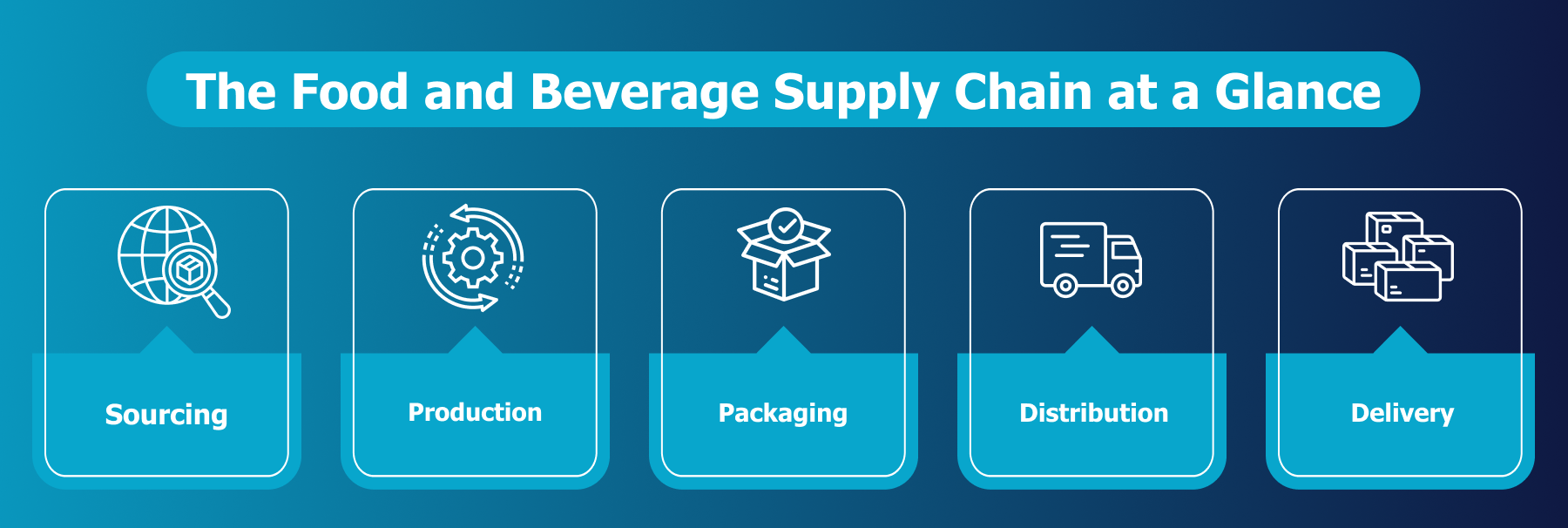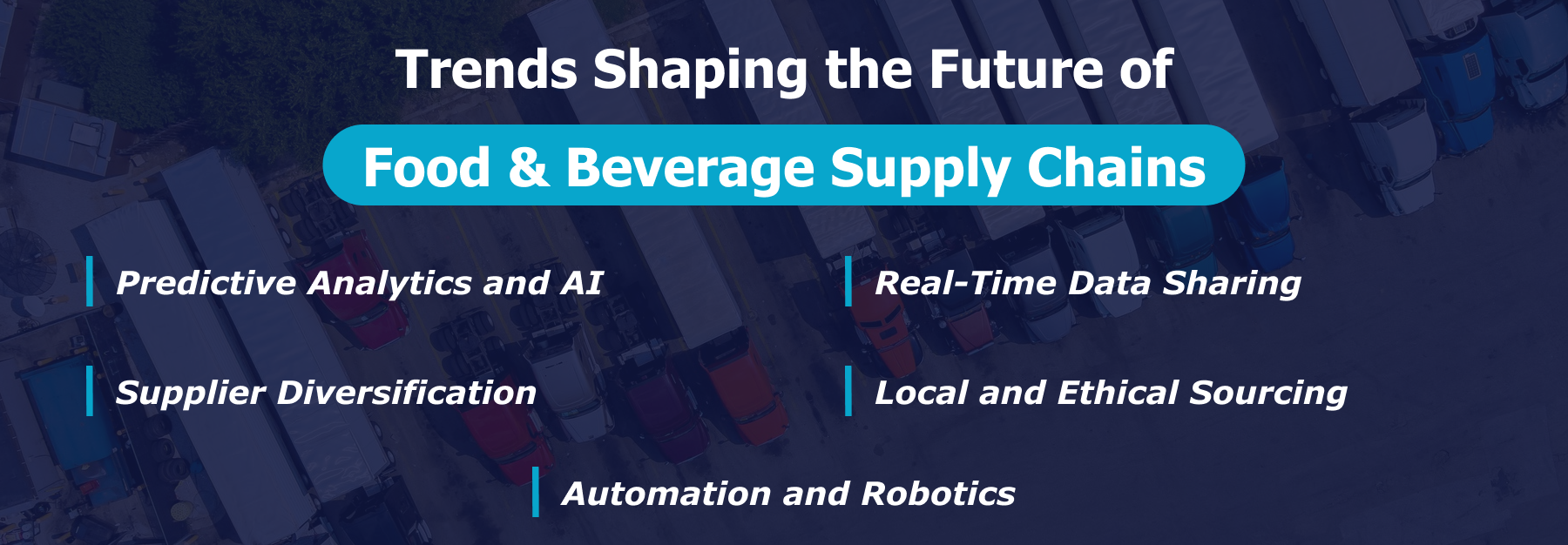When you really think about it, the food and beverage supply chain isn’t just about getting stuff from point A to point B. It’s what keeps the whole business alive. Every order, every truckload, every tiny detail plays a part in whether things run smoothly—or fall apart.
But today’s supply chains are more complex than ever. Disruptions, labor shortages, and shifting consumer demands are creating ongoing hurdles for operators, manufacturers, and distributors. The good news? Each of these food and beverage supply chain challenges can be overcome with the right mix of technology, visibility, and strategy.
What Is the Food and Beverage Supply Chain?

The food and beverage supply chain includes all the steps needed to make, move, and deliver food and drink products. That includes:
- Sourcing: Finding reliable suppliers and managing procurement contracts
- Production: Turning raw ingredients into finished products
- Packaging: Maintaining consistency, compliance, and quality
- Distribution: Coordinating transportation and warehousing efficiently
- Delivery: Ensuring the right products arrive on time, every time
Because the industry relies so much on freshness, safety, and timing, even small problems can lead to big ones. That’s why having access to real-time data and visibility into inventory levels, supplier performance, and distribution activity is so important for success.
Common Challenges in Food and Beverage Supply Chains

1. Limited Traceability and Visibility
One of the biggest problems with the food and drink supply chain is that there isn’t full transparency across the network. A lot of businesses still use old systems or separate spreadsheets that don’t give them a full picture of how well their supply chain is working.
What this causes:
- Slow responses to recalls that can put customers at risk
- Blind spots in cost changes, substitutions, and product quality
- Hidden waste and over-ordering because inventory accuracy is unreliable
- No accountability or performance insight across suppliers and distributors
- Teams stuck chasing data across systems
How to fix it:
- Use a central platform that links suppliers, distributors, and operators.
- Use real-time data to keep track of your inventory and scorecards for your suppliers.
- Use analytics that show how products move from start to finish.
The more your team can see, the faster you can act and the less trouble you’ll have.
2. Communication Gaps Between Stakeholders
When suppliers, distributors, and operators aren’t on the same page, small communication problems can lead to big mistakes. If you don’t manage your data well or report it consistently, you could end up with wrong forecasts, late shipments, and wasted inventory.
What this causes:
- Missed or inefficient deliveries that drive up labor and logistics costs
- Overstock or stockouts because partners can’t see true demand
- Slower response to menu changes, substitutions, or quality issues
- Forecasting becomes guesswork instead of a shared plan
How to fix it:
- Use cloud-based tools that let you share data in real time.
- Set up standard formats for reports
- Use dashboards that give everyone the same information.
Working together is no longer just a choice; it’s a way to get ahead of the competition.
3. Quality Control and Compliance Pressures
Quality control and following the rules are still two of the hardest problems in the food and drink supply chain. Internal teams can quickly become overwhelmed by keeping up with changing rules, paperwork, and supplier certifications.
Top risks include:
- Certifications that expire without warning, putting sales or partnerships at risk
- Inconsistent product quality across regions that damages brand trust
- Documentation gaps that can trigger fines or forced product withdrawals
- Slow response to regulation changes that leaves teams exposed to compliance failures
How to fix it:
- Automate compliance tracking and supplier documentation
- Centralize certification data for easy access
- Conduct proactive supplier performance reviews
A compliance strategy that is proactive and based on data helps lower risk and protect the brand’s reputation.
4. Logistics and Transportation Bottlenecks
Transportation problems can ruin even the best-planned buying plans. Supply chain leaders still have to deal with high freight costs, bad weather, and a lack of drivers.
Most common problems with logistics:
- Late or unpredictable deliveries that disrupt labor and service
- Rising freight and fuel costs that squeeze already-thin margins
- Carrier capacity shortages that limit flexibility and force rushed decisions
- Poor visibility into upcoming demand, making planning reactive instead of strategic
How to fix it:
- Use predictive analytics to figure out how much demand there will be and plan routes.
- Build stronger relationships with diversified carrier networks
- Integrate logistics insights into your overall supply chain planning process — whether that’s through a dashboard, shared reports, or structured collaboration with your carriers.
When logistics are integrated into your data strategy, you gain the agility to adapt quickly to change.
5. Sustainability and Waste Reduction
Sustainability isn’t just a trend anymore; it’s a must. Operators, distributors, and manufacturers are all under pressure to cut down on waste, emissions, and the way they get their supplies. The hard part is making money while doing it.
What makes sustainability difficult:
- Not enough information about waste points or inefficiencies
- Inconsistent reporting on the sustainability of suppliers
- Pressure to meet environmental targets without increasing operational costs
- Hard to quantify the financial upside of sustainability investments
How to fix it:
- Do regular waste audits to find the areas that need work.
- Use analytics to keep track of how resources are being used and how they affect things.
- Work with suppliers who share your goals for sustainability.
Not only are sustainable supply chains good for the environment, they’re also good for business in the long run.
Emerging Trends Impacting the Food and Beverage Supply Chain

The next wave of innovation is already changing how companies respond to challenges. A few trends are leading the charge:
- Predictive analytics and AI: Helping teams forecast demand and anticipate disruptions before they happen
- Supplier diversification: Reducing dependence on single suppliers for better flexibility
- Real-time data sharing: Improving collaboration and speed across the supply chain
- Local and ethical sourcing: Strengthening consumer trust and brand reputation
- Automation and robotics: Increasing accuracy and reducing labor-related delays
These trends are not only making things run more smoothly; they are also helping businesses make better, more environmentally friendly choices that will help them grow.
How ArrowStream Helps Fix Supply Chain Challenges
Running a modern food supply chain without trusted data isn’t just inefficient. It’s expensive. It’s risky. And it leaves operators reacting to problems instead of preventing them. The brands winning today are the ones who can see supply chain challenges coming and act fast.
ArrowStream connects operators, distributors, and manufacturers in one place, giving your team the visibility they need to run a tighter, more profitable business.
With ArrowStream, you can:
- Hold suppliers accountable with clear performance and quality insights
- Catch cost changes and purchasing trends before they erode margins
- Simplify contract management and compliance tracking
- Strengthen collaboration across your supply network
- Gain full visibility into your supply chain from end to end
When you have real-time intelligence behind every decision, recalls don’t catch you off guard, waste doesn’t go unnoticed, and cost surprises don’t show up on the P&L.
The reality is simple: the stakes are too high for guesswork. Supply chains move fast, and success belongs to the teams that move faster. ArrowStream gives operators, distributors, and manufacturers the clarity they need to protect profit, protect quality, and protect their brand.
